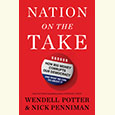Man is Clay
Smith Henderson’s haunting debut novel introduces a troubled Montana social worker and his mission to rescue children from peril—including his own
Fourth of July Creek, Smith Henderson’s stirring debut novel, is built around a central contradiction: Pete Snow, a beleaguered social worker, exhausts himself both physically and emotionally in trying to save the children of others, and yet he is unable to hold his own family together. The man who rushes into the home of a speed-addicted mother to sweep her waifish daughter into his arms—who shudders with pity as he feels her heart “thrumming in her little birdcage chest, the little pumping bird that raced in there”—is himself an alcoholic who spends most of his weekends “full blotto” and has never done much to hide or protect his own daughter from the consequences of his addiction.
 Snow’s territory is Tenmile, Montana, an equally contradictory enclave characterized by small-town charm and the beauty of the surrounding wilderness but also by the hard, heedless lives led by many of the people drawn to the edges of American civilization. Before long, through yet another child in peril, Pete finds himself involved with the most extreme element of this fringe—an anarchic survivalist named Jeremiah Pearl who drags his malnourished son along behind him as he wages his own private war against the government and waits for the coming apocalypse.
Snow’s territory is Tenmile, Montana, an equally contradictory enclave characterized by small-town charm and the beauty of the surrounding wilderness but also by the hard, heedless lives led by many of the people drawn to the edges of American civilization. Before long, through yet another child in peril, Pete finds himself involved with the most extreme element of this fringe—an anarchic survivalist named Jeremiah Pearl who drags his malnourished son along behind him as he wages his own private war against the government and waits for the coming apocalypse.
In Pete Snow, Smith Henderson has created a chastening portrait of someone assigned to the lost cause of saving the helpless from the careless ineptitude and cruelty of those who are supposed to love them most. The novel opens on the eve of the 1980 presidential election. Shifting demographics and the pessimism brought on by inflation, gas shortages, and the Iranian hostage crisis have set the stage for both Ronald Reagan’s defeat of Jimmy Carter and the increasing alienation of the marginal elements of society that tend to gravitate toward isolated places like Tenmile, Montana.
For Pete, an average day at the office consists of a litany of human misery like “newly suicided fathers and their wreckage” and a mother who wants to surrender her child because “God is telling her to kill him, you better hurry.” Though Fourth of July Creek owes much to the hard-edged, Dirty Realist tradition of Raymond Carver and the Richard Ford of Rock Springs, the book often feels closer in spirit to the nineteenth-century Naturalism of Stephen Crane and Jack London. Henderson is clearly determined to illustrate the inevitably tragic outcomes of the lives of children born into unconscionable circumstances, those with no one to turn to but an overburdened, underfunded system.
Pete himself seems at times less like a rescuer than a casualty. The heart of the novel lies in Pete’s own fractured psyche—especially his failed relationships with women: his ex-wife Beth, whom he loathes but who persistently reminds him of “a pleasure so total” that “he had mortgaged years to her and did not care”; Pete’s thirteen year-old daughter Rachel—his little “Applesauce”—whom he loves dearly but nevertheless allows to drift away; and Mary, a DFS colleague and former ward of the system with whom Pete embarks upon an affair too passionate and consuming to end well.
 Eventually, Beth leaves Tenmile for Texas, and Rachel, predictably, disappears, becoming another one of the lost children her father is supposed to save. “I take kids away from people like us,” Pete tells Beth. But it’s too late—Rachel has already been taken, not by the Department of Family Services, but by the street. Henderson interpolates the central narrative with chapters that chronicle Rachel’s harrowing journey—chapters that take the form of interviews placed in the kind of case file her father builds for the children of others.
Eventually, Beth leaves Tenmile for Texas, and Rachel, predictably, disappears, becoming another one of the lost children her father is supposed to save. “I take kids away from people like us,” Pete tells Beth. But it’s too late—Rachel has already been taken, not by the Department of Family Services, but by the street. Henderson interpolates the central narrative with chapters that chronicle Rachel’s harrowing journey—chapters that take the form of interviews placed in the kind of case file her father builds for the children of others.
In the novel’s final act, Pete finally immerses himself in the case of Benjamin Pearl and his volatile, paranoid father. Jeremiah Pearl—“Tribulation-ready, race war-ready”—has withdrawn from society to nurture a bizarre, quasi-Christian vision of a coming apocalypse that he hopes to hasten along with his anti-government activities. Aside from the neglect of his son’s physical well-being, Pearl’s only apparent crime is the harassment of various government officials with his favored calling card—defaced U.S. coins. As Pete grows more involved in the case, however, he learns that ATF and FBI officials suspect Pearl of affiliation with anarchist and white-supremacist terrorist groups. Through his misguided but well-meaning efforts to help the Pearls, Pete himself falls under suspicion, unwittingly setting the stage for a violent confrontation.
Fourth of July Creek is not for the faint of heart. Its depiction of the harsh realities faced by children born to parents struggling with mental illness and addiction is stark and unflinching. The many lengthy passages describing Pete’s epic alcoholic escapades are enough to make even Charles Bukowski or Frederick Exley wince. But Henderson, a gifted stylist, writes in lyrical prose reminiscent of Daniel Woodrell’s Winter’s Bone and the Tennessee novels of Cormac McCarthy. The plotting of the novel is also deft and ingenious, suggesting the work of a mature craftsman at the height of his powers.
Fourth of July Creek is a fine debut, worthy of the advance praise and the lofty comparisons it has garnered. Its singular achievement is Henderson’s empathy with Pete Snow—and with the deeply disturbed and disturbing Jeremiah Pearl. As Henderson succinctly suggests near the novel’s conclusion, “Pearl is Snow is himself is everyone.” In a seemingly exhausted landscape, Smith Henderson has broken fresh ground on which to document some of the darkest and most troubling aspects of American life at the end of the twentieth century, and beyond.

Ed Tarkington holds a B.A. from Furman University, an M.A. from the University of Virginia, and a Ph.D. from the creative-writing program at Florida State University. His debut novel, Only Love Can Break Your Heart, is forthcoming from Algonquin Books. He lives in Nashville.


